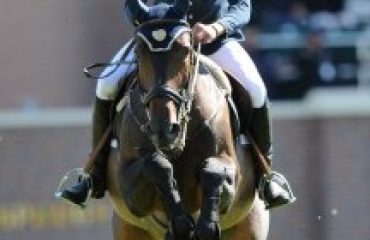
Boyd Martin riding Gloria Callen’s mare Welcome Shadow
Photo by Amber Heintzberger
Well known for both his fun-loving approach to life and his indefatigable work ethic, Boyd Martin has represented the U.S.A. in three-day eventing at two Olympic Games and two World Championships, and was on the gold-medal-winning Pan Am Games team in 2015. Boyd’s wife, Silva Martin, is a grand prix dressage rider and they have a son, Nox. Boyd and Silva train out of their own farm, Windurra USA in Cochranville, Pennsylvania, and spend winters at Stable View Farm in Aiken, South Carolina.
As an eventer, how do you benefit from spending time in Wellington, Florida, in the winter?
In February I spent ten days in Wellington with five of my upper-level horses. Phillip Dutton and I were encouraged to give this a try thanks to our new high-performance coach Eric Duvander. I must say it was a humbling experience jumping against the pros and competing at the AGDF 5* dressage show among some of the best in the world, but it was also inspiring and good for the horses and riders. This wasn’t only a change of scenery but different riders we were competing against, different judges and a totally different perspective than going to the usual horse trials and three-day events. It was good to get out of our comfort zone for a while.
Phillip and I have been working with dressage trainer Scott Hassler from Maryland for the past year or so, and Scott also helped us in Florida. Our jumping coach, Richard Picken, also made the trip with us and worked with us both at the barn where we were stabled and helped with coaching us in the classes at Winter Equestrian Festival.
How do you maintain the turf on your farm and schooling cross-country course?
The past couple of years I’ve gotten more and more involved with the Plantation CIC event, held near our farm in Pennsylvania every September. It’s an extremely important event for all the horses and the final preparation for Fair Hill, Pau or Galway Downs. A big part of this is improving the footing on their cross-country course, and working with the knowledgeable crew at Plantation has also improved my own education.
Jamie Hicks, most famous in Unionville for being one of the leading farmers specializing in hay, corn and soybeans, is also married to Kate Hicks, a 4* rider, and brings a unique connection to the table. We brought Jamie onto the Plantation Committee and he’s leading the charge in trying to make the footing on the course as good as anywhere in the world. Jamie also helps us with the footing at home at Windurra.
A couple of years ago one of America’s great racehorse trainers and footing experts, Michael Dickinson, was kind of enough to give Jamie and myself a three-hour presentation on the art of footing. He has an unbelievable training facility in North East, Maryland, with a number of grass gallops that are in pristine condition.
Our farm now has gallops with Attwood Equestrian Surfaces footing, but we still need to maintain the turf. In our session with Michael, the first section of our meeting covered equipment. Michael and his property manager Robert walked us through the various spreaders, mowers and agro-vators that they use on their grass gallops. The next segment covered going out into the field with Michael and watching this machinery work. Then he showed us all the types of grasses he recommends for gallops. Different varieties have pros and cons: for example, some are good in rain, some when it’s dry. On top of that he gave us a detailed overview of the care of grass, including fertilization, mowing height and irrigation.
Working with Michael gave both Jamie and I a clearer understanding of exactly what needs to be done to have good footing come cross-country day at Plantation. Establishing good turf takes years to get right, but with Michael mentoring Jamie we are on the right track, so to speak. Every year Jamie comes to our farm and spreads a layer of mushroom compost, seeds and fertilizes and aerates the land. Putting some time and effort into your pasture and galloping turf is an investment in your property and in your horses. I would encourage anyone interested in learning about establishing good turf to speak to a professional, since it really is a lot more involved than throwing some grass seed on the ground and hoping that it grows!
What type of barn do you like for your horses?
We have shed row barns built by Horizon Structures, a company based in Pennsylvania. I like the shed row style barns because they’re very workmanlike, with easy access to the horses and good ventilation. There are lots of configurations to their prefabricated stabling, so you can figure out what works best for your style and budget.
I recommend having two latches on your stable doors; one at the top and one at the bottom, so that horses that like to play with the latch are less likely to escape. I also recommend having a safe place to hang your halter and lead ropes, out of reach of playful horses. Also, be sure to secure your feed and tack areas. Unplug electrical items that you aren’t using, keep a fire extinguisher handy and post emergency phone numbers someplace visible and accessible. A landline phone is a good idea if you can install one.
It’s always a good idea to keep your aisle or stable area neat and workmanlike rather than leaving things lying about for a horse or person to trip over. While your barn doesn’t have to look like a showplace, keeping things organized and tidied up will help you take the best care of your horse and work safely in the barn, and you won’t waste a lot of time looking around for misplaced tools and tack.












